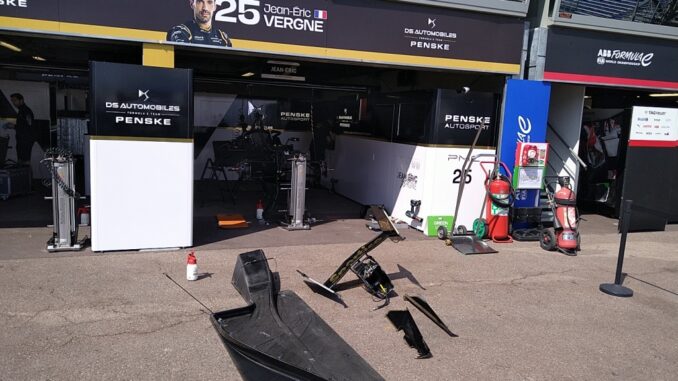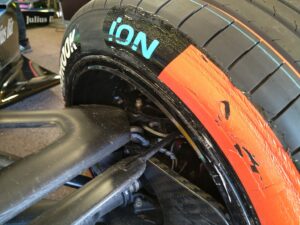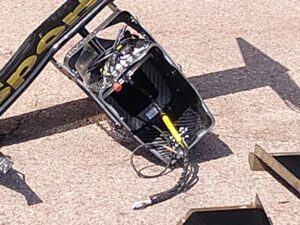
In caso di incidente molte componenti dell’ auto possono staccarsi e rappresentare un pericolo per il pubblico o per le altre auto vicine.
Storicamente sono tristemente noti episodi in cui a causa del cedimento completo della sospensione, pneumatici completi sono schizzati via andando a causare vittime tra gli spettatori.
 Sulla scia di questi casi sono stati gradualmente introdotti i tether di sicurezza, cioè dei robusti cavi che collegano al telaio queste componenti critiche impedendogli di allontanarsi dal corpo principale del telaio.
Sulla scia di questi casi sono stati gradualmente introdotti i tether di sicurezza, cioè dei robusti cavi che collegano al telaio queste componenti critiche impedendogli di allontanarsi dal corpo principale del telaio.
Le strutture di collegamento normali (sospensioni o carrozzeria) sono rigide e quindi in caso di forte urto si spezzano, soprattutto nel caso di forze come torsioni che non fanno parte delle normali forze che il pezzo deve sopportare in condizioni di funzionamento normale.
Un cavo di collegamento invece essendo flessibile non viene danneggiato durante l’urto e poi si dispone in maniera naturale lungo la direttrice delle forze lavorando solo in pura trazione (modo di lavoro ottimale per un cavo). Questo permette al cavo di trattenere con sicurezza le componenti anche durante urti che sbriciolano facilmente tutte le altre parti della macchina.
Il vincolo di sicurezza fa parte dei requisiti obbligatori da rispettare per i costruttori e il regolamento specifica chiaramente quali sono le forze massime a cui i cavi devono resistere e dove devono essere vincolati.
Nel caso specifico della Formula E essendo molte parti della auto in comune tra tutti i team e fornite dall’organizzatore anche questi dettagli fanno parte del kit standard.
Nelle foto possiamo vedere alcuni di questi cavi che collegano le ruote o la parte di carenatura posteriore al telaio.
I tether delle ruote sono descritti in modo molto specifico nel regolamento tecnico all’articolo 10.5 che citiamo testualmente di seguito:
In order to help prevent a wheel from becoming separated in the event due to suspension members failing, provision must be made to accommodate flexible tethers, each with a cross sectional area greater than 110 mm². The sole purpose of the tethers is to prevent a wheel from becoming separated from the car; they should perform no other function.
The tethers and their attachments must also be designed in order to help prevent a wheel from making contact with the driver’s head during an accident.
Each wheel must be fitted with two tethers, each of which complies with the FIA standard 8864-2013 and must be mentioned on the FIA Technical List n°37 and have a minimum energy absorption of 7kJ.
Each tether must have its own separate attachments at both ends, which:
− are able to withstand a tensile force of 70 kN in any direction within a cone of 45° (included angle) measured from the load line of the relevant suspension member.
− on the survival cell or the rear casing structure are separated by at least 100 mm measured between the centres of the two attachment points.
− on each wheel/upright assembly are located on opposite sides of the vertical and horizontal wheel centre lines and are separated by at least 100 mm measured between the centres of the two attachment points.
− are able to accommodate tether end fittings with a minimum inside diameter of 15 mm.
Furthermore, no suspension member may contain more than one tether.
Each tether must exceed 450 mm in length and must utilise end fittings which result in a tether bend radius greater than 7.5 mm.
 L’ articolo 14.6 invece descrive il tether delativo alla carenatura posteriore che svolge anche il ruolo di assorbitore di impatto. Di seguito citiamo l’articolo del regolamento:
L’ articolo 14.6 invece descrive il tether delativo alla carenatura posteriore che svolge anche il ruolo di assorbitore di impatto. Di seguito citiamo l’articolo del regolamento:
In order to help prevent a rear impact structure becoming separated following an accident, a flexible tether must be fitted. The sole purpose of the tether is to prevent the rear impact structure becoming separated from the car and should perform no other function.
One tether which complies with FIA standard 8864-2013 providing a minimum energy absorption of 3kJ (FIA Technical List No.37) must be fitted.The tether must exceed 600mm in length and must utilize end fittings which result in a tether bend radius greater than 7.5mm.
The tether must have its own attachments at both ends which:
− Are able to withstand a tensile force of 40kN (included angle) measured from the load line. Should the tether generate a higher load before reaching an energy absorption of 3kJ, the acceptable load of the attachment must be increased accordingly.
− Could be shared on gearbox side with the wheel tether attachment required by Article 10.5.
− Are lying on either side of the expected point of failure. The chassis manufacturer must demonstrate by calculation and / or physical tests that the attachment points are different sides of the expected point of failure when applying a lateral load to the most rearward point of the rear impact absorbing structure.
− Are able to accomodate a tether end fitting with a minimum inside diameter of 15mm.
#SimoneRambaldi #theEMNteam










Be the first to comment